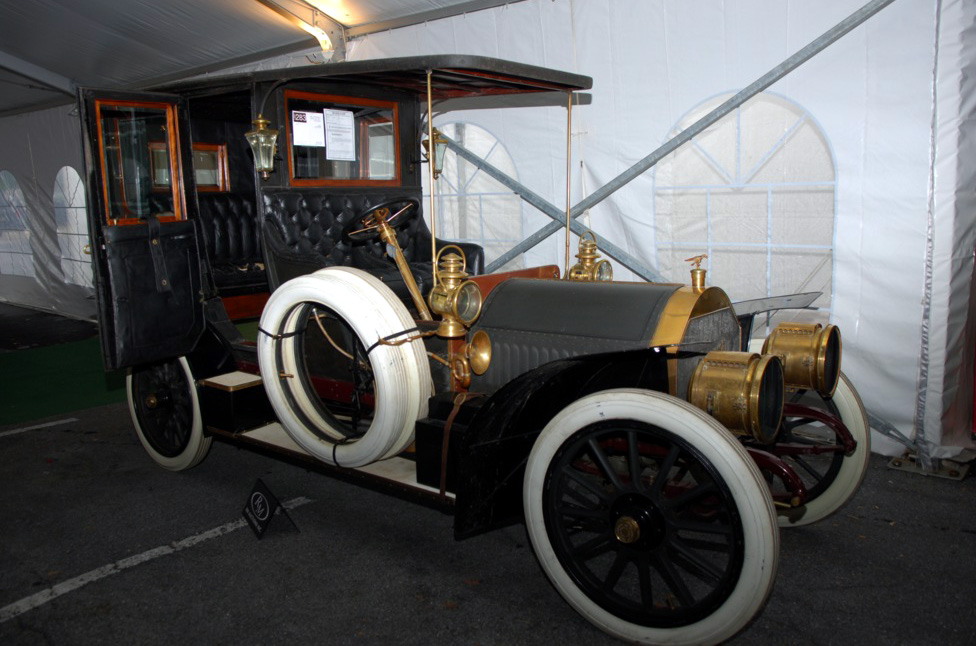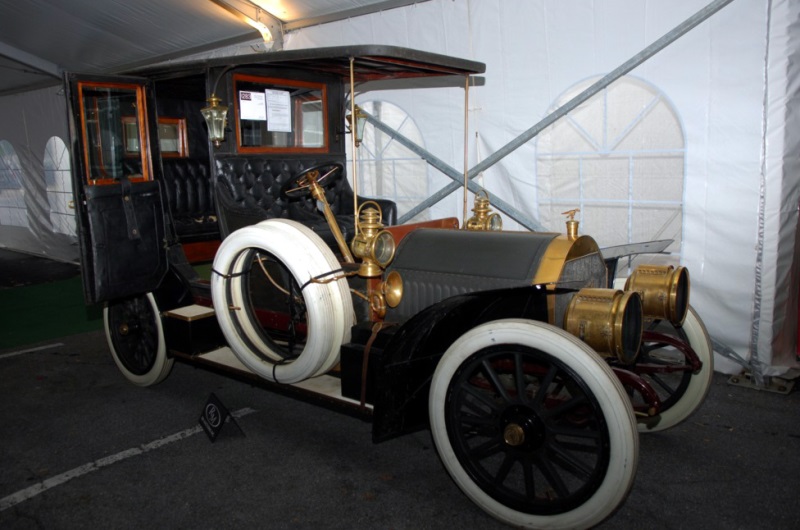The first American automobile to be victorious in the Vanderbilt Cup race in Long Island was the 120 horsepower, Locomoile 'Old Sixteen.' It bested a field of the finest factory cars from around the globe, solidifying Locomobile's ranking among the greatest pre-World War I manufacturers. Even without this racing success, the Locomboile vehicles were renowned for their uncompromising standards of quality and without concern for cost, exemplified by its most famous feature - the solid bronze crankcase. They were among the most expensive and elegant automobiles manufactured in the United States and became favored by the East Coast aristocracy and the West Coast/Hollywood elite.
Limousine
Chassis #: 2111
View info and history
Auction entries : 1The origins of the Locomobile Company began with a takeover of the fledgling Stanley Motor Carriage Company by 'Cosmopolitan' magazine publisher John Brisben Walker in 1899. Walker, who had paid the Stanely brothers $250,000 to build a new and improved Stanely Steamer, was joined by his neighbor and asphalt paving magnate, Amzi Lorenzo Barber. Unfortunately, this partnership quickly fell apart, with each parting ways to build and sell practically identical cars. The designs of both these vehicles had originated with the Stanley Brothers, with Walker's Locomobile promoted via the company slogan of 'Easily the Best Built Car in America.' The Locomobiles exhibited good hill climbing potential and were easy to keep running, however, their strong appetite and non-condoning design required frequent refilling. Despite this drawback, the Locomoible became the largest motor vehicle producer in America. As 1900 was coming to a close, Locomobile introduced a more robust four-seat steam carriage known as the Style 5, also known as the Locosurrey. Its chassis rested on robust hubs with reinforced axles, and its elegantly constructed body retained the appearance of the famous Loco - albeit, with an additional seat. To cope with the extra mass, the braking system now consisted of four bands, with two at the differential and two on the rear wheels. The Locomobiles were among the fastest road transport of their day, proven when S.T. Davis Jr. drove a specially prepared racer over the measured mile in 1902 at an average speed of 48 mph. Although quick, the steamer was no match for the range of gasoline-powered vehicles. Several thousand examples of the Locomobile Steamer were built before they were discontinued in early 1904, as the company switched over to gasoline-powered cars exclusively.
Runabout
View info and historyThe early gasoline-powered Locomobiles employed multi-cylinder inline engines in a T-head configuration. The engine drove through a rear-mounted transmission that, in turn powered the back wheels through a dual chain drive. This configuration had been costly to build and develop, but it was among the most advanced configuration of its time and resulted in a very reliable and durable automobile. The four-model range was scaled down to two in 1906, the 15/20hp Model E and the 30/35hp Model H. The Model E rested on a 93-inch wheelbase and the Model H on a 106-inch platform. Touring and Limousine body styles were offered for both models, with the Fishtail Runabout being exclusive to the Model E. Prices of the Model H were much higher than the Model E, with the Model H Limousine priced at $6,200 compared to $3,700 for the Model E Limousine. The 1908 Locomobile lineup included the Model E Standard Tourer resting on a 102-inch wheelbase, priced at $2,900, and powered by a 20-horsepower, four-cylinder engine. The Model E had a 116-inch wheelbase and was priced at $4,200 for the limousine and $4,300 for the landaulet. The Model I was the top-of-the-line model with its runabout resting on a 123-inch wheelbase, priced at $4,750, and powered by a four-cylinder engine with 40 horsepower. The Locomobiles used a sliding gear three-speed transmission built in unit with the cross-shaft for the double chain drive to the rear axle. The suspension was comprised of semi-elliptical leaf springs on both the front and rear axles and stopping power was by drum brakes on the rear axle. 
Runabout
View info and historyOld 16
'Old 16' had been built for the 1906 Vanderbilt racer, where it was piloted, as #12, by Joe Tracy. It won the elimination race and had the fastest lap time of any entry but was consigned to finish 10th in the main race following tire trouble. French driver Louis Wagner took the sport's first checkered flag in a Darracq. A melee broke out in the crowds at the 1906 event, resulting in the death of a spectator. There was no Vanderbilt Cup race in 1907 but returned in 1908 after race promoter William 'Willie K.' Vanderbilt II had completed a private highway, the Long Island Motor Parkway, which provided a safer course for the race and also opened up Long Island to greater development. Locomobile dusted off its two-year-old race car and re-numbered as 16. Driving duties for the 1908 event were entrusted to George Robertson who set a furious pace and eventually won the race, setting a new record average speed of 64.3 mph. Locomobile retired from racing after its monumental victory, focusing its efforts on building large and luxurious vehicles. The luxury car segment was among the first to feel the effects of the Great Depression, and by 1932 the company was forced to close its doors after its parent company, Durant Motors failed.
by Daniel Vaughan | Jan 2022

Limousine
Chassis #: 2111
View info and history
Auction entries : 1

Runabout
View info and history

Runabout
View info and history
'Old 16' had been built for the 1906 Vanderbilt racer, where it was piloted, as #12, by Joe Tracy. It won the elimination race and had the fastest lap time of any entry but was consigned to finish 10th in the main race following tire trouble. French driver Louis Wagner took the sport's first checkered flag in a Darracq. A melee broke out in the crowds at the 1906 event, resulting in the death of a spectator. There was no Vanderbilt Cup race in 1907 but returned in 1908 after race promoter William 'Willie K.' Vanderbilt II had completed a private highway, the Long Island Motor Parkway, which provided a safer course for the race and also opened up Long Island to greater development. Locomobile dusted off its two-year-old race car and re-numbered as 16. Driving duties for the 1908 event were entrusted to George Robertson who set a furious pace and eventually won the race, setting a new record average speed of 64.3 mph. Locomobile retired from racing after its monumental victory, focusing its efforts on building large and luxurious vehicles. The luxury car segment was among the first to feel the effects of the Great Depression, and by 1932 the company was forced to close its doors after its parent company, Durant Motors failed.
by Daniel Vaughan | Jan 2022
Related Reading : Locomobile Model 40 History
Identical twin brothers Freelan Oscar and Francis Edgar Stanley were one of the first motorcar producers in the United States and one of the more successful in steam-powered car production. Freelan Oscar and his wife are credited with being the first individuals to drive an automobile to the top of New Hampshires Mount Washington on August 31st, 1899. Their Locomobile steam runabout took two hours....
Continue Reading >>
Continue Reading >>
Locomobile
Similar Automakers
Similarly Priced Vehicles
- Baker Electric ($1,200-$4,000)
- Ford Model K ($2,800-$2,800)
- Stanley Steamer Model K ($1,800-$4,500)
- American Underslung Model 50 ($3,750-$3,750)
- Thomas Flyer F ($4,500-$5,700)
- White Model L ($2,500-$3,200)
- Packard Model Thirty ($4,250-$5,650)
- Pierce-Arrow Great Arrow ($4,000-$6,500)
- Stearns Model 30-60 ($4,600-$4,750)
- American Simplex Model D-50 ($4,000-$5,400)
- Columbia Electric ($900-$3,500)
Average Auction Sale: $209,000
1908 Locomobile Model 40 Type I Vehicle Profiles
Recent Vehicle Additions
Performance and Specification Comparison
Price Comparison
Model 40 Specification Comparison by Year
Year
Production
Wheelbase
Engine
Prices
Related Automotive News

Cars Of A Bygone Era Shine As The Pre-Eminent Auction House For Early Collectibles Returns To Hershey
Award Winning Pre-War Motor Cars and Premium Automobilia are on Offer as RM Sothebys, the Official Auction of the Eastern Division AACA National Fall Meet, returns to Hershey, 4-5 October
RM Sothebys returns to the Hershey Lodge for th...

The Best of the Brass Era: Gooding & Company Announces a 1914 Mercer Type 35-J Raceabout and a 1913 Lozier Type 72 Meadowbrook Runabout for Its 2023 Pebble Beach Auctions
This August, the auction house will present a 1914 Mercer Type 35-J Raceabout and a 1913 Lozier Type 72 Meadowbrook Runabout from the Jerry S. Foley III Estate, alongside a 1933 Alfa Romeo 8C 2300 Cabriolet and a desirable 1936 Hispano-Suiza J12 Cabriolet.
...

Cobble Beach Concours : Best of Show
The 7th annual Cobble Beach Concours dElegance was held near Owen Sound in the Township of Georgian Bluffs at the Cobble Beach Waterfront Golf Resort Community in Canada. It is a luxury four-season resort nestled on 574 acres with an 18 hole links...
HILTON HEAD ISLAND MOTORING FESTIVAL & CONCOURS D'ELEGANCE ANNOUNCES EXPANSION OF 2014 SAVANNAH SPEED CLASSIC
Celebrating a decade of vintage racing, the Savannah Speed Classic boasts exciting additions, brings racing back to its roots
HILTON HEAD ISLAND, S.C. – The Hilton Head Island Motoring Festival %26 Concours dElegance (HHIMF), one of the...

Breaking news from Coys
1966 AC Shelby Cobra - Now selling at No Reserve!
Coys are pleased to announce that a 1966 AC Shelby Cobra will now be selling at No Reserve later today at the Autosport International show at the NEC in Birmingham.
Featured on the front cover...























